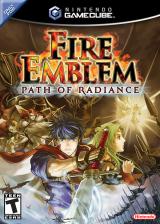Path of Radiance is a heavily story-driven game, and just like the GBA Fire Emblems, its writing is sharp and compelling. The story revolves around the Greil Mercenaries, a heroic band of "sellswords" whose work primarily revolves around policing the less-populated areas of their home country, Crimea. One day, one of their operatives brings grim news: the nation of Daein has invaded the Crimean capitol, and all but leveling it.
Dedicated to defending their homeland, the Greil Mercenaries set out investigate, and soon enough, they meet a battalion of Daein soldiers. It is thus that they're drawn into this monumental conflict. The son of Greil himself (and eventual heir to the company's leadership), a wet-behind-the-ears swordsman named Ike, experiences his coming of age as a consequence. The story, in short, is just what you'd expect from this sort of epic fantasy. The story moves via sparsely animated dialogue windows, just like in the GBA games, with occasional in-engine cutscenes placed here and there to accentuate pivotal moments in the plot. The latter are extremely well done, and stand as a stark contrast to the often-heavy dialogue. But again, with dialogue as well-written as the stuff Path of Radiance, you're bound to get drawn into the story anyway, regardless of your attention span for this sort of thing.

The gameplay formula hasn't changed a bit either. Everything is divided into a linear series of chapters, in which the units that you field are typically pitted against overwhelming odds, and as a result, these turn-based battles are very intense. The tendency to painstakingly strategize every move, which has surely been instilled in you if you've played the previous games, is reinforced here -- every unit in your force has a name, story, and personality, and if they die on the battlefield, it's curtains forever. Sure, certain key characters will still appear in narrative cutscenes after they get "killed" in battle; they're just written off as incapacitated, for the purpose of warfare.





 Good
Good


